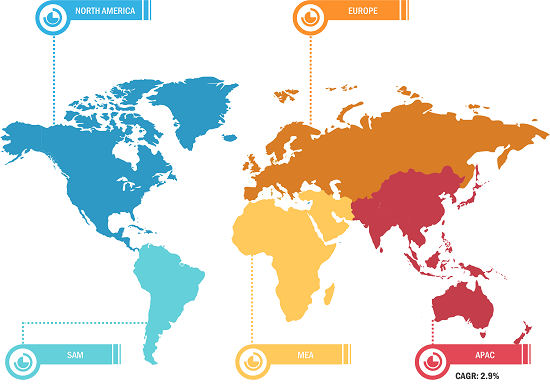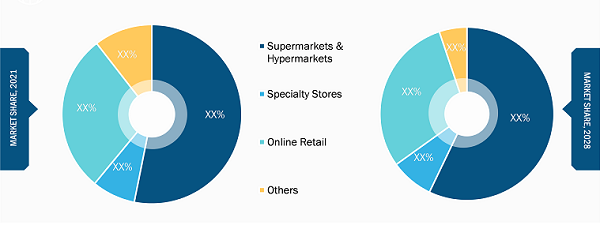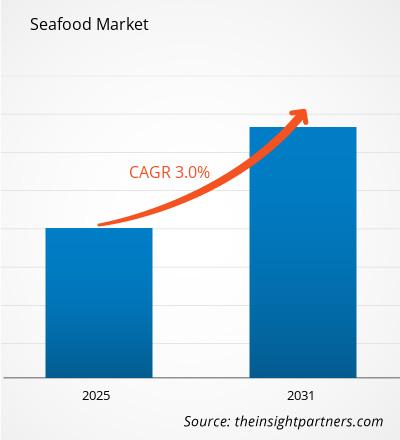Si prevede che il mercato dei prodotti ittici crescerà da 1.71.493,93 milioni di dollari nel 2022 a 1.71.493,93 milioni di dollari nel 2022 2.01.253,49 milioni entro il 2031; si prevede che crescerà a un CAGR del 3,0% dal 2022 al 2031.
La Food and Drug Administration (FDA) ha dichiarato che i frutti di mare comprendono tutti i pesci d'acqua dolce e salata ottenuti a livello commerciale, i molluschi e i crostacei. Si prevede che la domanda di prodotti ittici vedrà una crescita drammatica in tutto il mondo a causa dei suoi benefici per la salute. Secondo la FAO, entro il 2030, per soddisfare la crescente domanda dei prossimi anni sarà necessario un valore aggiuntivo di 40 milioni di tonnellate di prodotti ittici, ovvero un incremento del 30% circa. Inoltre, si prevede che l'aumento del consumo pro capite accompagnato dalla domanda di prodotti ittici importati da parte della ricca nazione sosterrà la crescita del mercato nel periodo di previsione.
L'Asia Pacifico deteneva la quota maggiore del mercato dei frutti di mare nel 2021. Paesi come Giappone, Cina e Corea del Sud hanno un significato tradizionale del pesce nelle loro culture; pertanto, è probabile che l’elevata domanda di pesce in questi paesi alimenterà la crescita dell’industria dei prodotti ittici. Oltre al pesce fresco, anche il pesce in scatola è molto apprezzato dalla popolazione della regione. Ad esempio, il tonno è molto popolare tra gli asiatici grazie al suo gusto accattivante e alla capacità di fondersi bene con molteplici sapori. I prodotti a base di tonno in scatola presentano sapori unici rispetto a quelli convenzionali che stanno penetrando nel mercato APAC. Inoltre, il sistema di distribuzione potenziato con i crescenti servizi di e-commerce sta guidando la crescita del mercato dei prodotti ittici.
Approfondimenti strategici
Ripartizione del mercato dei prodotti ittici – per regione

Approfondimenti di mercato
Aumento della domanda di frutti di mare congelati e in scatola
Con la crescente domanda di prodotti ittici trasformati, il mercato dei prodotti ittici congelati e in scatola è in rapida crescita in tutto il mondo. I prodotti ittici congelati vengono congelati, il che aiuta a prevenire la forma batterica dei prodotti alimentari e ne aumenta la durata di conservazione. Allo stesso modo, il pesce in scatola viene lavorato e conservato in un contenitore sigillato e ermetico come un barattolo di alluminio o di latta. Il pesce in scatola ha solitamente una durata di conservazione di 1-5 anni. I prodotti ittici in scatola stanno guadagnando un enorme successo tra i consumatori a causa della crescente domanda di cibi pronti. Allo stesso modo, anche frutti di mare surgelati viene accolto positivamente dai consumatori, spingendo la crescita del mercato. Con l’introduzione della tecnologia emergente, i frutti di mare congelati mantengono il valore nutrizionale e il sapore simile al pesce fresco. Il congelamento rallenta il processo di decomposizione, preservandone così il valore nutrizionale. Il pesce congelato entro poche ore dalla cattura contiene vitamine ben conservate. È stato riscontrato che il pesce fresco è soggetto a un rapido degrado e ha una durata di conservazione più breve. Pertanto, la crescente esigenza di praticità e una maggiore durata di conservazione offerta dai prodotti ittici in scatola e congelati, insieme alle crescenti attività di ricerca e sviluppo da parte dei principali attori, stanno guidando la crescita del mercato dei prodotti ittici in tutto il mondo.
Approfondimenti basati sul tipo di prodotto
< p>In base al tipo di prodotto, il mercato dei prodotti ittici è segmentato in pesce, crostacei, molluschi e altri. Si prevede che il segmento dei crostacei registrerà il CAGR più elevato durante il periodo di previsione. I crostacei sono membri del subphylum dei Crostacei (phylum Arthropoda), un gruppo di animali invertebrati che comprende circa 45.000 specie in tutto il mondo. Il gruppo dei crostacei comprende alcuni frutti di mare comunemente consumati come granchi, gamberi, aragoste, gamberi, krill e cirripedi. Aiutano nella perdita di peso, aiutano a rafforzare l'immunità e promuovono il calore e la salute. salute del cervello. Granchio al curry & gnocchi, newburg di aragosta, gamberetti in vaso, moeche, zuppa di gamberetti, gamberi ai cereali e zuppe di granchio sono alcuni dei piatti più famosi preparati con crostacei e vengono consumati in tutto il mondo.Approfondimenti sui canali di distribuzione
In base alla distribuzione, il mercato dei prodotti ittici è segmentato in supermercati e ipermercati, negozi specializzati, vendita al dettaglio online e altri. I supermercati & Il segmento degli ipermercati deteneva la quota maggiore del mercato dei prodotti ittici nel 2021. Supermercati e ipermercati si riferiscono a negozi di auto-aiuto che offrono un'ampia varietà di prodotti in vendita. Seafood ha una sezione dedicata nei supermercati e negli ipermercati. Pertanto, ai clienti viene offerta un'ampia varietà di opzioni, soprattutto nel reparto congelatore. I banchi del pesce di supermercati e ipermercati sono considerati luoghi eccellenti per acquistare un'ampia varietà di frutti di mare freschi e congelati. Si prevede che questi fattori guideranno la crescita del segmento.
Mercato dei frutti di mare, per canale di distribuzione – 2022 e 2031 < /strong>
< /strong>
Alcuni dei principali attori che operano nel mercato dei prodotti ittici sono American Seafoods Company LLC, Kangamiut Seafood A/C, Lee Fishing Company, Pacific American Fish Co. Inc., Royal Greenland A/S, Mowi ASA, The Union Group PCL, Grupo Nueva Pescanova, Trident Seafoods Corporation e SeaPak Shrimp & Azienda di frutti di mare. Questi attori sono impegnati nello sviluppo di prodotti con rischi per la salute ridotti per soddisfare le tendenze emergenti dei consumatori e rispettare i quadri normativi. Sono coinvolti in fusioni e acquisizioni, espansioni aziendali e partnership per espandere la propria quota di mercato.
Segnala Spotlights
- Tendenze progressive del settore nel mercato dei prodotti ittici per aiutare i giocatori a sviluppare strategie efficaci a lungo termine
- Strategie di crescita aziendale adottate per garantire la crescita nei mercati sviluppati e in via di sviluppo
- Analisi quantitativa del mercato dei prodotti ittici dal 2022 al 2031
- Stima della domanda globale di prodotti ittici
- Analisi delle cinque forze di Porter per illustrare l'efficacia di acquirenti e fornitori che operano nel settore
- Recenti sviluppi per comprendere lo scenario del mercato competitivo
- Tendenze e prospettive del mercato e fattori che governano la crescita del mercato dei prodotti ittici
- Assistenza nel processo decisionale evidenziando le strategie di mercato che sostengono l'interesse commerciale, portando alla crescita del mercato
- Dimensione del mercato dei frutti di mare in vari nodi
- Panoramica dettagliata e segmentazione del mercato e delle dinamiche del settore alimentare e delle bevande
- Dimensione della crescita in varie regioni con promettenti opportunità di crescita
- Analisi storica (2 anni), anno base, previsione (7 anni) con CAGR
- Analisi PEST e SWOT
- Valore/volume delle dimensioni del mercato - Globale, regionale, nazionale
- Industria e panorama competitivo
- Set di dati Excel



Report Coverage
Revenue forecast, Company Analysis, Industry landscape, Growth factors, and Trends

Segment Covered
This text is related
to segments covered.

Regional Scope
North America, Europe, Asia Pacific, Middle East & Africa, South & Central America

Country Scope
This text is related
to country scope.
Domande frequenti
The major players operating in the global seafood market are American Seafoods Company LLC, Kangamiut Seafood A/C, Lee Fishing Company, Pacific American Fish Co. Inc., Royal Greenland A/S, Mowi ASA, The Union Group PCL, Grupo Nueva Pescanova, Trident Seafoods Corporation, SeaPak Shrimp & Seafood Company among many others.
In 2019, the Asia Pacific held the largest share of the global seafood market. Asia Pacific is a mature and well-established market for seafood. Countries such as Japan, China, and South Korea have a traditional significance of fish in their cultures, and hence, the high demand for fish in these countries is likely to fuel the growth of the seafood market. In addition to fresh seafood, canned seafood is also highly embraced by the region’s population. For instance, tuna is highly popular among the Asian people attributed to its appealing taste and ability to blend well with multiple flavors. The canned tuna products penetrating the Asian market are exhibiting unique flavors apart from the conventional ones. However, in recent years the canned tuna sales in the region have been declining due to the consumers swaying towards other seafood, particularly shellfish. Thus, the manufacturers have been innovating their products in terms of base ingredients that can attract consumers. However, in Australia, canned tuna sales are escalating.
The growth of the crustaceans type segment is primarily attributed to the fact as many species of crustaceans are found in freshwater, seawater and also in inland brines. The crustaceans group include some commonly consumed seafoods like crab, shrimp, lobsters, prawns, crayfish, krill and barnacles. These crustaceans develop form larvae and bear segmented, split limbs or appendages. The fisheries in many parts of the world capture prawns, shrimps, spiny lobsters and king crabs, especially from the Northern Pacific and its southern counterparts. Many species of true crabs like the blue crab, Dungeness crab and stone crab serves as a valuable source of food. Crustaceans are consumed as seafoods as they are loaded with lean proteins, micronutrients and healthy fats. They aid in weight loss, helps in boosting immunity and promotes heat & brain health.
Trends and growth analysis reports related to Food and Beverages : READ MORE..
The List of Companies - Global Seafood Market
- American Seafoods Company LLC
- Kangamiut Seafood A/C
- Lee Fishing Company
- Pacific American Fish Co. Inc.
- Royal Greenland A/S
- Mowi ASA
- The Union Group PCL
- Grupo Nueva Pescanova
- Trident Seafoods Corporation
- SeaPak Shrimp & Seafood Company
The Insight Partners performs research in 4 major stages: Data Collection & Secondary Research, Primary Research, Data Analysis and Data Triangulation & Final Review.
- Data Collection and Secondary Research:
As a market research and consulting firm operating from a decade, we have published and advised several client across the globe. First step for any study will start with an assessment of currently available data and insights from existing reports. Further, historical and current market information is collected from Investor Presentations, Annual Reports, SEC Filings, etc., and other information related to company’s performance and market positioning are gathered from Paid Databases (Factiva, Hoovers, and Reuters) and various other publications available in public domain.
Several associations trade associates, technical forums, institutes, societies and organization are accessed to gain technical as well as market related insights through their publications such as research papers, blogs and press releases related to the studies are referred to get cues about the market. Further, white papers, journals, magazines, and other news articles published in last 3 years are scrutinized and analyzed to understand the current market trends.
- Primary Research:
The primarily interview analysis comprise of data obtained from industry participants interview and answers to survey questions gathered by in-house primary team.
For primary research, interviews are conducted with industry experts/CEOs/Marketing Managers/VPs/Subject Matter Experts from both demand and supply side to get a 360-degree view of the market. The primary team conducts several interviews based on the complexity of the markets to understand the various market trends and dynamics which makes research more credible and precise.
A typical research interview fulfils the following functions:
- Provides first-hand information on the market size, market trends, growth trends, competitive landscape, and outlook
- Validates and strengthens in-house secondary research findings
- Develops the analysis team’s expertise and market understanding
Primary research involves email interactions and telephone interviews for each market, category, segment, and sub-segment across geographies. The participants who typically take part in such a process include, but are not limited to:
- Industry participants: VPs, business development managers, market intelligence managers and national sales managers
- Outside experts: Valuation experts, research analysts and key opinion leaders specializing in the electronics and semiconductor industry.
Below is the breakup of our primary respondents by company, designation, and region:

Once we receive the confirmation from primary research sources or primary respondents, we finalize the base year market estimation and forecast the data as per the macroeconomic and microeconomic factors assessed during data collection.
- Data Analysis:
Once data is validated through both secondary as well as primary respondents, we finalize the market estimations by hypothesis formulation and factor analysis at regional and country level.
- Macro-Economic Factor Analysis:
We analyse macroeconomic indicators such the gross domestic product (GDP), increase in the demand for goods and services across industries, technological advancement, regional economic growth, governmental policies, the influence of COVID-19, PEST analysis, and other aspects. This analysis aids in setting benchmarks for various nations/regions and approximating market splits. Additionally, the general trend of the aforementioned components aid in determining the market's development possibilities.
- Country Level Data:
Various factors that are especially aligned to the country are taken into account to determine the market size for a certain area and country, including the presence of vendors, such as headquarters and offices, the country's GDP, demand patterns, and industry growth. To comprehend the market dynamics for the nation, a number of growth variables, inhibitors, application areas, and current market trends are researched. The aforementioned elements aid in determining the country's overall market's growth potential.
- Company Profile:
The “Table of Contents” is formulated by listing and analyzing more than 25 - 30 companies operating in the market ecosystem across geographies. However, we profile only 10 companies as a standard practice in our syndicate reports. These 10 companies comprise leading, emerging, and regional players. Nonetheless, our analysis is not restricted to the 10 listed companies, we also analyze other companies present in the market to develop a holistic view and understand the prevailing trends. The “Company Profiles” section in the report covers key facts, business description, products & services, financial information, SWOT analysis, and key developments. The financial information presented is extracted from the annual reports and official documents of the publicly listed companies. Upon collecting the information for the sections of respective companies, we verify them via various primary sources and then compile the data in respective company profiles. The company level information helps us in deriving the base number as well as in forecasting the market size.
- Developing Base Number:
Aggregation of sales statistics (2020-2022) and macro-economic factor, and other secondary and primary research insights are utilized to arrive at base number and related market shares for 2022. The data gaps are identified in this step and relevant market data is analyzed, collected from paid primary interviews or databases. On finalizing the base year market size, forecasts are developed on the basis of macro-economic, industry and market growth factors and company level analysis.
- Data Triangulation and Final Review:
The market findings and base year market size calculations are validated from supply as well as demand side. Demand side validations are based on macro-economic factor analysis and benchmarks for respective regions and countries. In case of supply side validations, revenues of major companies are estimated (in case not available) based on industry benchmark, approximate number of employees, product portfolio, and primary interviews revenues are gathered. Further revenue from target product/service segment is assessed to avoid overshooting of market statistics. In case of heavy deviations between supply and demand side values, all thes steps are repeated to achieve synchronization.
We follow an iterative model, wherein we share our research findings with Subject Matter Experts (SME’s) and Key Opinion Leaders (KOLs) until consensus view of the market is not formulated – this model negates any drastic deviation in the opinions of experts. Only validated and universally acceptable research findings are quoted in our reports.
We have important check points that we use to validate our research findings – which we call – data triangulation, where we validate the information, we generate from secondary sources with primary interviews and then we re-validate with our internal data bases and Subject matter experts. This comprehensive model enables us to deliver high quality, reliable data in shortest possible time.

 Ottieni un campione gratuito per questo repot
Ottieni un campione gratuito per questo repot